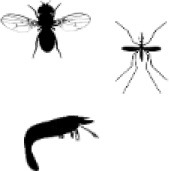Table 1.
Evidence of invertebrate PRR and GPCR function in host-microbiota communication.
| Genomic Featuresa | Role in the metaorganism | References | |
|---|---|---|---|
 Porifera |
|
|
(19–24) |
 Cnidaria |
|
|
(25–33) |
 Annelida |
|
(34) | |
 Mollusca |
|
|
(35–39) |
 Nematoda Nematoda |
|
|
(40–46) |
 Arthropoda |
|
|
(47–63) |
 Echinodermata |
|
(64–67) |
Silhouette images downloaded from PhyloPic or drawn by the Authors in Inkscape (no copyright).
According to specified references and/or Buckley and Rast (64). CTLR, C-type lectin receptors; GPCR, G-protein coupled receptor; Ig, immunoglobulin; NLR, NOD-like receptor; PGRP, peptidoglycan recognition protein; PRR, pattern recognition receptor; SR, scavenger receptor; SRCR, scavenger receptor cysteine-rich; TIR, Toll-Interleukin receptor; TLR, Toll-like receptor.
